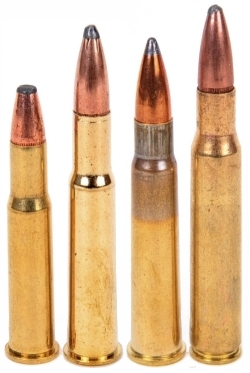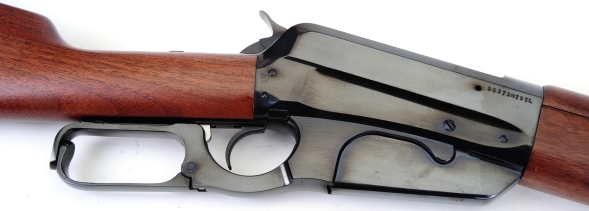
The 30-40 Krag’s brevity of popularity might be attributed to its short military service. The 30-40 Krag was in and out of uniform in and out in approximately 11 years. Even the 45-70 Government round was an official military cartridge for 19 years, 100+ years for the 30-06 Springfield, 60+ years for the 308 Winchester, and 50+ years for the 223 Remington. Brief service meant an absence of a long term supply of inexpensive military surplus firearms and a minimal amount of cheap surplus ammunition to make the round popular with sportsman. There were also far fewer servicemen returning home feeling a close association with the 30-40 Krag. With such little momentum driving the popularity of the cartridge, there were few firearms in this chamber produced for the consumer market. Demand for a cartridge of this performance level was probably services by the .303 British round. Too bad.
The 30-40 Krag looks like a 30-30 WCF that someone tugged on until its cylindrical surfaces were about 0.040″ larger. To place the 30-40 Krag into a more specific and less imagist context, the following multicolored table offers some fairly credible data. Appearing up to down, as pictured left… in order left to right. That was fun.
|
Cartridge |
Case Length” |
Cartridge Length” | Capacity H2O Grains |
Maximum Pressure PSI |
| 30-30 WCF | 2.039 | 2.550 | 44 | 42,000 |
| 30-40 Krag | 2.314 | 3.089 | 58 | 47,000 |
| 303 British | 2.213 | 3.075 | 56 | 49,000 |
| 30-06 Springfield | 2.494 | 3.340 | 68 | 60,000 |
The 30-40 Krag in association with the Model 1895
There is a good deal of credible handloading information available for the 30-40 Krag and there is also a great deal of nuance information. The handload data appearing in this piece applies to the Winchester Model 1895 and does not take into consideration the mechanical idiosyncrasies of the Krag-Jorgensen bolt action rifle and its very long and widely toleranced freebore. The Winchester Model 1895 subject rifle is a modern firearm, built on modern tooling to incredibly consistent and tight tolerances. Subsequently, old handloading manuals text that suggests “only load long, heavy, round nose bullets” be used to achieve accuracy does not apply.
I think some folks reloading the 30-40 Krag get hung up on freebore by associating the condition with a time when freebore might run several thousandths of an inch over groove diameter and a bullet was not supported before rifling obturation. The notion is that a bullet will not enter rifling centered… although I am not exactly sure how it would remain crooked when being hot footed through a 22″ – 26″ undersize swaging die. These days freebore groove diameter so this is not really an issue, even as a theory. Anecdotal evidence? Sure. Weatherby Range Certified .308″ boomers than can group half MOA have a freebore of 0.361″. The spec for the 30-40 Krag is a maximum freebore of 0.330″.
The handload data below reflects the most common weight 30 caliber bullets that cover the broadest hunting application. Surely these are great deer, hog and black bear loads and I’ve no doubt the heavier bullets would be fine for elk and moose. No attempt was made to push pressures into the ionosphere, but rather standard pressure loads that would be consistent with the intent and application of cartridge and rifle.
Warning: Bullet selections are specific, and loads are not valid with substitutions of different bullets of the same weight. Variations in bullet length will alter net case capacity, pressure and velocity. Primer selection is specific and primer types are not interchangeable. These are maximum loads in my firearms and may easily be excessive in others. All loads should be reduced by 2%, and developed following safe handloading practices as represented in established reloading manuals produced by component manufacturers. Presentation of these loads does not constitute a solicitation for their use, nor a recommendation.
|
|||||||||||||||||||||||||||||||||||||||||||||||||||||||||||||||||||||||||||||||||||||||||||||||||||||||||||||||||||||||||
|
|||||||||||||||||||||||||||||||||||||||||||||||||||||||||||||||||||||||||||||||||||||||||||||||||||||||||||||||||||||||||

Winchester’s Model 1895 – Part 1
Winchester’s Model 1895 – Part 2

Email Notification